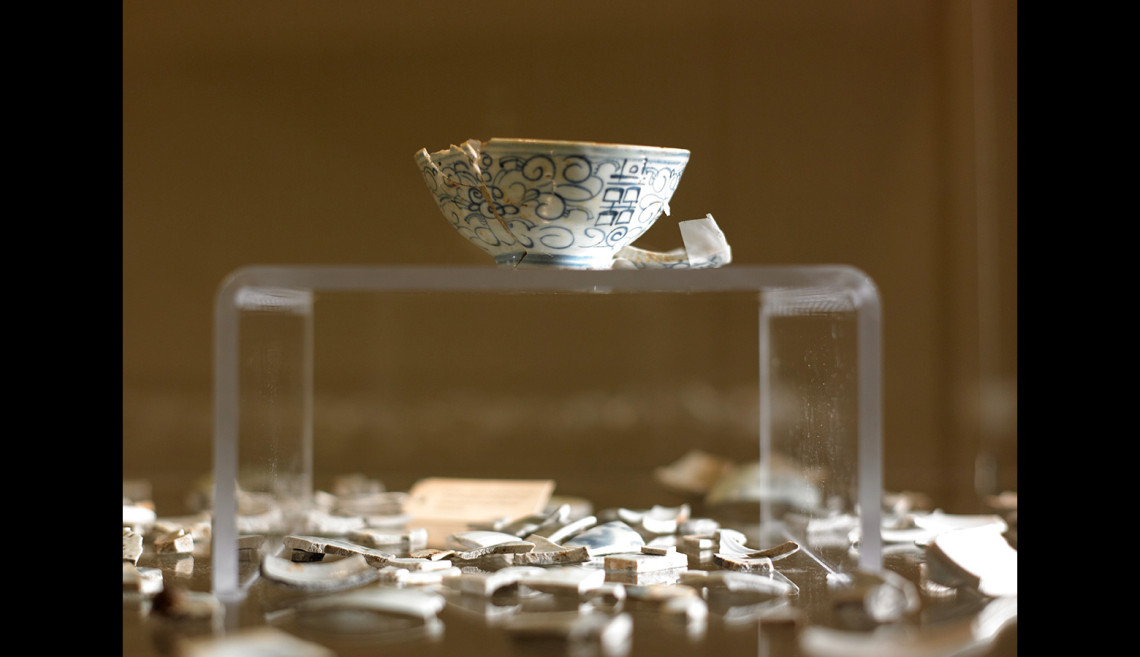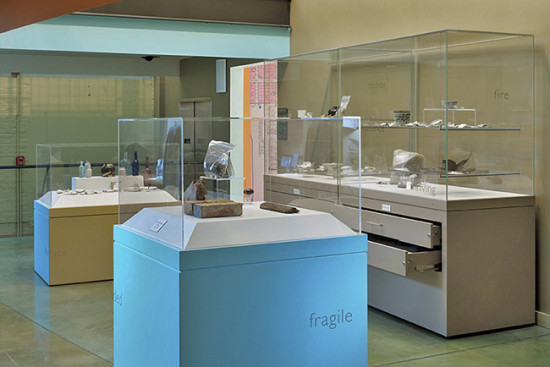
Partially reconstructed Double Happiness rice bowl surrounded by shards of Bamboo rice bowls. The names "Double Happiness" and "Bamboo" refer to the very popular painted motifs painted on the bowl.
Keith BakerStanford exhibit of San Jose’s lost Chinatown brings archaeology out of the laboratory
The "City Beneath the City" installation at the Stanford Archaeology Center combines history and art for an insightful examination of local Bay Area history.
Visitors to the Stanford Archaeology Center find modern glass cases filled with fragments of a lost city – wooden toothbrushes and combs, buttons and leather shoes, ceramic bowls and soup spoons. These are the remnants of the once thriving Chinatown community in downtown San José.
Today, these archaeological findings populate City Beneath the City, an art installation designed by artist and Stanford alum Rene Yung. The exhibit marks the first time these 150-year-old artifacts have been on display on campus.

Free to the public and running until June 30, City Beneath the City offers a glimpse into one of the largest Chinese communities in America in the 19th century. Yung, who has developed exhibits that address social issues for museums in Europe and the United States, wanted to draw attention to the racism that culminated with arson and the destruction of the Market Street Chinatown in 1887.
Today, many of the whole and fragmented rice bowls, opium pipes and glass bottles that survived the fire sit in pristine display cases.
“We still have much to learn about our past, which is important to appreciate our present.”
Beneath the glass boxes are metal drawers, “the guts, the depths of that history” that visitors open in order to reveal the items inside – hair combs, a porcelain doll leg. These are essentially re-buried when the drawers close, until the next visitor reveals them once again.
The simple lines and interactive aspect of the design, Yung said, are meant to evoke questions about the people behind these artifacts – what were their lives like among these objects, against the backdrop of hostility against the Chinese in their adopted country?
Yung, herself an immigrant from Hong Kong who spent her teen years in the South Bay, designed the installation to reflect “a dynamic set of relationships between fragments and whole, history and present.” The porcelain bowls and colorful glass vials are beautiful to look at, but they are not just aesthetic items – they are “complex objects bearing social, cultural and political significance,” she added.

For two decades in the late 1800s, the community was home to more than 1,000 Chinese immigrants. Thousands more visited the area to see family, pick up mail, go to restaurants, see doctors or attend shows at the local opera house. Following the fire in 1887, the artifacts that are now part of City Beneath the City lay buried for a century before being excavated in the 1980s. A lack of resources meant they received little attention for another 20 years.
Barbara Voss, a Stanford associate professor in anthropology, became the primary investigator on the Market Street Chinatown Archaeology Project in 2002 when Stanford partnered with the Chinese Historical and Cultural Project and History San José to curate thousands of artifacts ranging from household and personal items to seeds and animal bones.
Since then, dozens of Stanford students have worked tirelessly cataloguing and preserving these items. Among them is Megan Kane, an anthropological sciences major who graduated in 2008 and was hired two years later as the project’s collections and public outreach manager.
Market Street Chinatown is “a snapshot in time of what a Chinese community was like in the 19th century,” said Kane. Sometimes, the findings are surprising. For example, bone analysis revealed that the local diet included specialties like bear paw soup, a delicacy that in China was reserved for only the wealthiest upper classes. Whether this was common in other contemporary Chinese settlements is hard to tell, Kane said, because the Market Street Chinatown is one of the few to have been excavated to any significant degree.
City Beneath the City, said Voss, “gets archaeology out of the laboratory,” helping inform community members and Stanford students about local history. “The seemingly mundane items are a record of daily life that has been missing about the Chinese who were there and then vanished,” said Voss.
Stanford students in Voss’ course, Public Archaeology, took a hands-on role in preparing the items for display, discussing exhibition themes with the artist and serving as volunteer docents for weekend tours. “This collaboration has given students an opportunity to explore the relationship between past and present,” Voss said. “Typically, archaeologists use materials from the past to learn about the past, but Rene Yung has shown us how artifacts can be used to spark new perceptions about present-day issues.”
Gordon Chang, a Stanford professor of American history and close colleague of Voss’, said the Market Street Chinatown artifacts “continue to confirm that U.S. history is diverse and vibrant.” These pieces of history show us “we still have much to learn about our past, which is important to appreciate our present,” he added. “Their history is part of all of our history in California.”
The installation originated as part of the 2012 “Seeking Silicon Valley” art festival at the San José Institute of Contemporary Art. The exhibit was so well-received that the institute and Stanford agreed to give the installation an extended presence at the Stanford Archaeology Center in 2013.
Kane said she believes the exhibit gets the public involved in a meaningful way with archaeological findings. “Very personal memories come out from this exhibition,” she said, explaining that many visitors have shared stories inspired by seeing the artifacts. “People tell us, ‘I heard my family lived there,’ or ‘My grandmother used that same product,’ or ‘The spoons are the same as the ones we had.’ “
These touching personal stories, Kane said, encourage her to think about the human aspect behind the pieces of archaeological discovery she works with daily.
In addition to the exhibit, the curious can interact with this era in history during quarterly public digs organized by the Stanford Archaeology Center in collaboration with History San José and the Chinese Historical and Cultural Project. “Involving kids in history in a hands-on way really inspires them,” said Kane, who wants to see the next generation of archaeologists excited about digging in the dirt.
